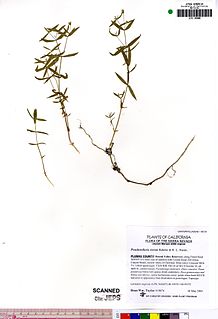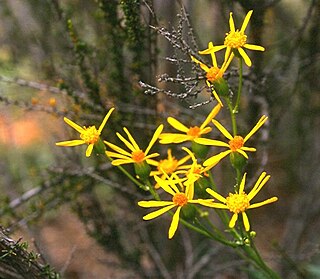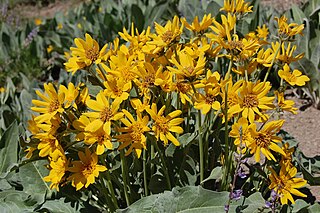
Argemone munita is a species of prickly poppy known by the common names flatbud prickly poppy and chicalote. "Munita" means "armed", in reference to the many long prickles. This flower is native to California, where it is widespread throughout the western part of the state and its eastern deserts, on slopes to 10,000 feet, and along roadsides. Its range also extends into Baja California, Arizona, and Nevada.

Gentianopsis holopetala is a species of flowering plant in the gentian family known by the common names Sierra fringed gentian or just "Sierra gentian"'. It is native to the Sierra Nevada and adjacent mountains in California and Nevada, in wet meadows from 6000 to 11,000 ft in elevation. This is an annual or perennial herb, growing stems which may be anywhere from a few centimeters long to nearly half a meter, and may lay along the ground or grow erect. Its small oval or spoon-shaped leaves are mostly basal but may grow sparsely further along the stem.

Hackelia nervosa is a species of flowering plant in the borage family known by the common name Sierra stickseed. It is native to the mountains of California, especially the Sierra Nevada and its foothills, in areas with some moisture up to near treeline. Its range may extend into Nevada.

Ivesia webberi is a species of flowering plant in the rose family known by the common names wire mousetail and Webber's ivesia. It is native to the United States, where it occurs in the northernmost part of the Sierra Nevada and the adjacent Modoc Plateau in California, its range extending just into Nevada.

Allium tuolumnense is a rare species of wild onion, known by the common name Rawhide Hill onion.

Allium tribracteatum, known by the common name Threebract onion, is a species of wild onion found in California.

Arnica nevadensis is a North American species of arnica in the sunflower family, known by the common names Nevada arnica and Sierra arnica. It is native to the coniferous forests of the western United States, primarily the Cascades and Sierra Nevada.

Calochortus leichtlinii is a species of flowering plant in the lily family known by the common names Leichtlin's mariposa, smokey mariposa, and mariposa lily.

Calochortus minimus is a California species of flowering plants in the lily family known by the common name Sierra mariposa lily.

Calochortus monophyllus is a North American species of flowering plants in the lily family known by the common name yellow star-tulip.
Caulanthus californicus is a species of flowering plant in the family Brassicaceae known by the common names California jewelflower and St. Francis cabbage.
Chaenactis alpigena is a species of flowering plant in the daisy family known by the common name southern Sierra pincushion. It is native to the High Sierra Nevada and the White Mountains of California, extending in the latter just into Nevada.
Hackelia amethystina is a species of flowering plant in the borage family known by the common name amethyst stickseed.

Pseudostellaria sierrae is a species of flowering plant in the family Caryophyllaceae known by the common name Sierra starwort.

Rudbeckia californica is a species of flowering plant in the family Asteraceae, known by the common name California coneflower.

Packera layneae, known by the common name Layne's ragwort and Layne's butterweed, is a rare species of flowering plant in the aster family.

Sidalcea stipularis is a rare species of flowering plant in the mallow family, known by the common name Scadden Flat checkerbloom.
Tripterocalyx crux-maltae is a species of flowering plant in the four o'clock family known by the common names Lassen sandverbena and Kellogg's sand-verbena.

Wyethia mollis is a species of flowering plant in the aster family known by the common name woolly mule's ears. The plant is hairy to woolly in texture, sometimes losing its hairs with age.
Gilia yorkii is a rare species of flowering plant in the phlox family known by the common names Boyden Cave gilia and monarch gilia. It is endemic to Fresno County, California, where it is known from only one location in the southern Sierra Nevada. This plant grows in rock cracks in the limestone cliffs and outcrops in the chaparral and woodlands of the canyon.
















